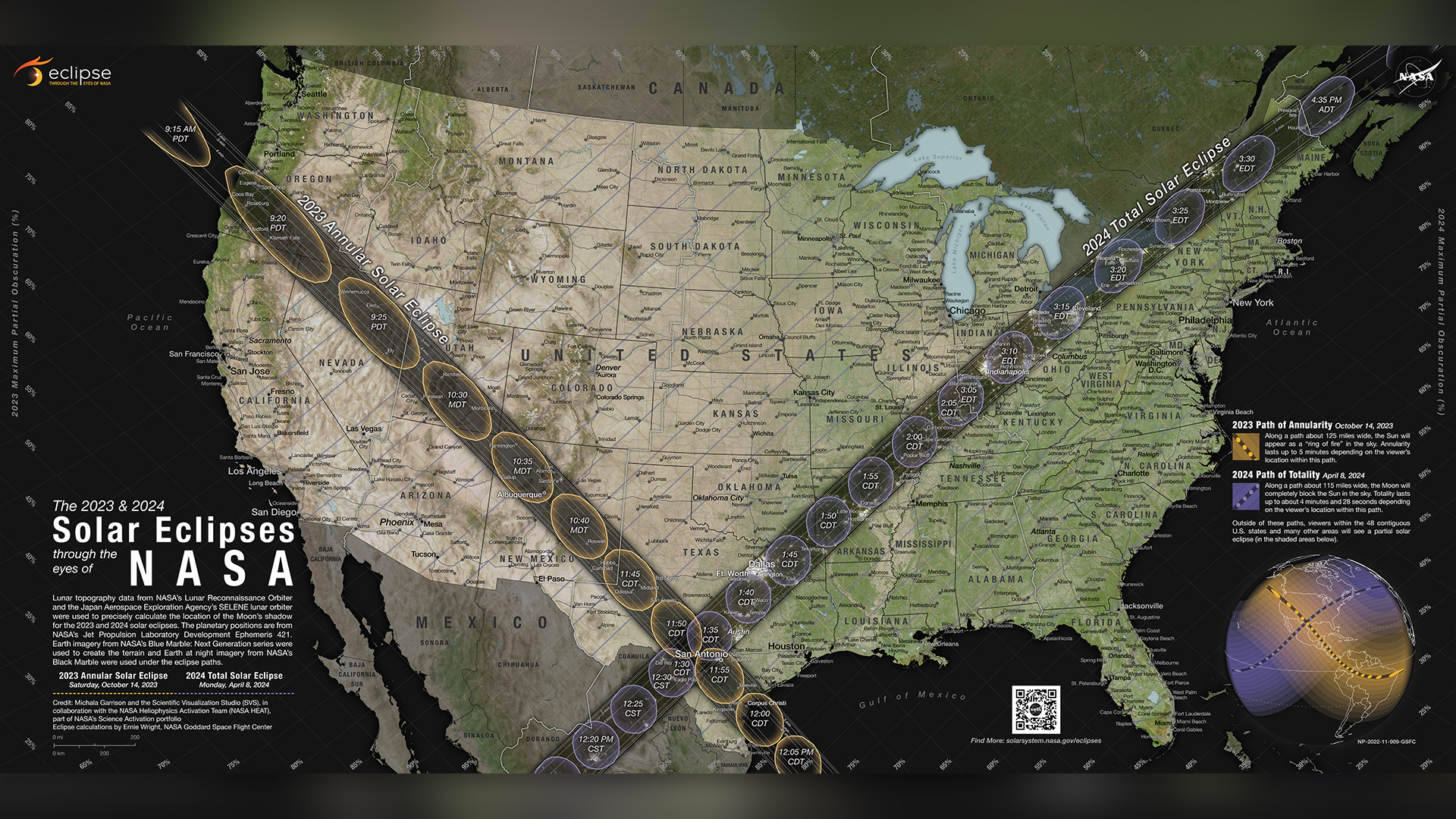April 8 solar eclipse: What is the path of totality, and where's the best spot to watch?
On April 8, a total solar eclipse will be visible in 15 U.S. states that sit along the path of totality. But how does the path of totality work, and where's the best viewing spot? Here's everything you need to know.

On April 8, a total solar eclipse will be visible from parts of North America for the first time since 2017 and for the last time until 2033.
To experience totality — darkness in the daytime and the chance to look at the sun's fiery outer atmosphere, or corona, with naked eyes — you must be within the 115-mile-wide (185 kilometers), 10,000-mile-long (16,000 km) path of totality.
But you may be wondering a few things: What is the path of totality, how does it work, and where should you go for the best view?
What is the path of totality?
Simply put, the path of totality is the moon's moving shadow. Caused by the moon's umbra — its dark, cone-shaped central shadow — the path of totality will cross parts of Mexico, the U.S. and Canada on April 8, including the following states and provinces:
- Mexico: Sinaloa, Nayarit, Durango, Chihuahua and Coahuila
- U.S.: Texas, Oklahoma, Arkansas, Missouri, Illinois, Kentucky, Tennessee, Michigan, Indiana, Ohio, Pennsylvania, New York, Vermont, New Hampshire and Maine
- Canada: Ontario, Quebec, New Brunswick, Prince Edward Island, Nova Scotia and Newfoundland
"The moon always has a shadow — there's always an eclipse out there somewhere — but we have to wait for it to scrape across the Earth to see an eclipse," solar eclipse tracker Dan McGlaun, founder of Eclipse2024.org, told Live Science. "If you're in that shadow at a certain time, you'll see totality." (McGlaun created an interactive map and eclipse simulator to show what thousands of communities in North America can expect to see during the upcoming eclipse.)
How to find the best spot on the path
On April 8, the moon's umbra will move from southwest to northeast. This is due to the angle of Earth's tilted axis, but also because the moon orbits from west to east faster than Earth rotates. Meanwhile, the path's width results from the exact distance of the moon from Earth.
Related: April 8 total solar eclipse: The best places to stargaze near the path of totality
Get the world’s most fascinating discoveries delivered straight to your inbox.
The specific location within the path of totality determines how long totality lasts there. "The closer you are to the center, the more duration you get because the shadow is round," McGlaun said. "Totality gets shorter towards the path's edges, and it's zero right on the edge."
However, where you are along the path of totality also makes a difference; the maximum possible duration of totality on April 8 is 4 minutes, 28 seconds, which will occur in Nazas, Mexico. (Here's how long totality will last in 10 major cities in the path of the eclipse.)
"Earth is round, so when [the moon's shadow] hits the middle part that bulges out, it's closer to the moon," McGlaun said. This is where the shadow moves at its slowest and where the path of totality is at its widest. "When it hits the edges of the Earth, the moon is farthest away — just [by] a few thousand miles — but that's enough to make a difference because the shadow is a cone," McGlaun added.
However, the best place to be on April 8 is more complex. "Get anywhere in the path on eclipse day," McGlaun said, but instead of obsessing about being close to the centerline, there's something else you need to think about if you want to see the sun's corona during totality. "Anywhere in the path where there's clear weather is the best place to be," he said.

Jamie Carter is a freelance journalist and regular Live Science contributor based in Cardiff, U.K. He is the author of A Stargazing Program For Beginners and lectures on astronomy and the natural world. Jamie regularly writes for Space.com, TechRadar.com, Forbes Science, BBC Wildlife magazine and Scientific American, and many others. He edits WhenIsTheNextEclipse.com.



